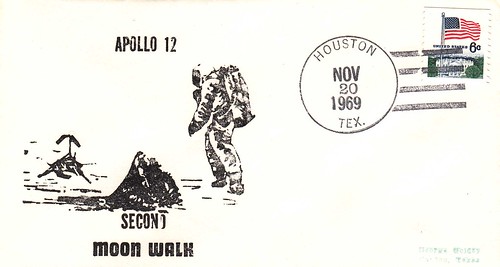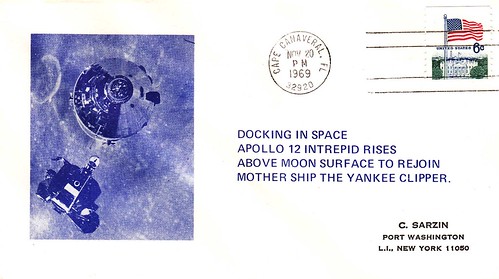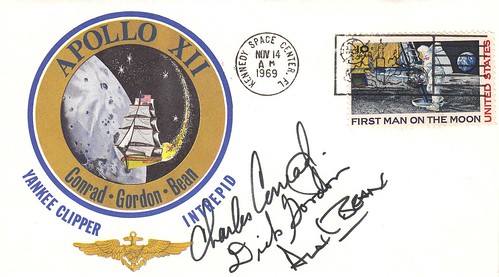The Apollo 12 mission cover shown is signed by the Apollo 12 crew of Charles (Pete) Conrad, Dick Gordon, and Alan Bean. The cover is similar to normal crew patch covers except it also adds Navy astronaut wings to the cachet and adds the name of the Command Module, Yankee Clipper; and the Lunar Module, Intrepid for the mission. The Apollo 12 crew is an all Navy crew and the ship symbolism builds upon an earlier speech by President John F. Kennedy also a U.S. Navy veteran in which he stated the American people will embark upon a "new ocean in an earlier Presidential address."Space Cover #433: The Incredible Space Mission of Apollo 12!
"Liftoff," radios Commander Pete Conrad, "The clock is running" as Apollo 12 slowly lifts away from its launch pad. The massive Saturn V responds amazingly well and completes its roll over to its track heading as it thunders into the stormy skies over Cape Canaveral. Suddenly Conrad looks out of the corner of his eye and sees a bright flash of lightning followed by loud static noise on his headset and a trembling of the mighty Apollo 12 Saturn rocket. Only Conrad had observed the lightning flash, but all of the crew had heard the repetitive and urgent warning of the instrument panel's master alarm reverberating in their headsets. The instrument panel was a blur of warning lights indicating the spacecraft's electrical system had been knocked out by the lightning strike.
The flight continues on rocket power but with the possibility of the Command Module only having battery power and then becoming a dead spacecraft without power for emergency reentry. Mission Control engineers immediately attack the problem and are able to quickly restore telemetry data flow after asking the crew to reset signal condition equipment to auxiliary. Mission Control CapCom Jerry Carr then urgently advises the crew to try resetting their electrical bus to get their knocked out fuel cells back on line.
Conrad calls out to his crewmates, "Wait for staging!" The crew sees the first stage of the Saturn V rocket fall away. The crew is slammed into their harnesses as its Saturn's second stage rocket engines thunder to life, cut-in, and accelerating them forward as expected. After staging, Alan Bean is able to reset the spacecraft's electrical bus, and the Command Module's electrical system suddenly comes back to life on line. As Apollo 12 speeds into Earth orbit, spacecraft operations appear to return to normal. Conrad excitely looks at his crew mates, suddenly laughs and shouts, "Was that ever a sim (simulation) they gave us?! There were so many lights up there I couldn't read them all!"
Apollo 11 crew had missed their lunar landing point by four miles. NASA mathematician Emil Schiesser made a key breakthrough and using Doppler shift in frequency, was able to predict if the lunar module was on course or not, and how much correction would be required. It is an elegant solution to a complicated problem. As requested by Mission Control, Pete Conrad and Alan Bean in lunar lander Intrepid think they have landed fairly close to the Surveyor 3 lander a target to visit on their mission. Conrad had landed on target, he was sure of that.
On the Sea of Storms where Conrad and Bean had landed, Conrad descends from the ladder on the Intrepid Lunar Module's porch, he holds onto the ladder with both hands and then gently jumps down onto the lander's footpad and then to the lunar surface. Conrad exclaims, "Man that may have been a small one (step)for Neil, but it's a long one for me!" But, he is then surprised by what he then sees. On the far side of a crater's wall and standing in the moon's surface shadows is the white diminutive shape of Surveyor 3. Conrad exclaims,"Does that look neat? It can't be any further than six hundred feet from here. How about that?!" Intrepid had landed within sight of Surveyor 3 on the Ocean of Storms.

On their second moonwalk, Conrad and Bean head towards Surveyor 3 and its crater in a slightly uphill run. They take photos of nearby lunar soil and rock samples so NASA can compare the photos with those taken by Surveyor 3 thirty-one months previously. The astronauts also wrestle with the TV camera of Surveyor 3 and clip it free from Surveyor's camera mount. Conrad exclaims, "It's ours!" and puts it into their tool carrier. Conrad looks at Bean and sees he is worried. He asks, "Beano, are you worried about the (ascent) engine? Alan Bean answers, "Yep." Conrad quietly continues, "Well, there's no sense worrying about it, Al, because if it doesn't work, we're just gonna become the first permanent monument to the space program!"

An hour later, the ascent engine fires on Intrepid's command. As the Ocean of Storms recedes, Intrepid rejoins CM Pilot Dick Gordon and Yankee Clipper in lunar orbit and successfully docks. Commander Pete Conrad was exuberant over Apollo 12 and his crew's achievements: their recovery from unexpected lightning strikes on launch, their pinpoint landing at the Sea of Storms, their reconnoitering of the Surveyor 3 lunar lander on the moon, and accomplishment of all of their mission's objectives setting an even higher benchmark for future Apollo manned spaceflight missions.

On their homeward trip back to Earth, LM Pilot Alan Bean observes, "As Pete Conrad, Dick Gordon, and I were speeding back towards Earth in our Command Module, we were treated to a marvelous sight never before seen by any humans. We were seeing our home planet Earth eclipse our own star, the Sun. As we were about 27,000 miles out, the Earth moved to completely obscure the disk of the Sun. I reported to Mission Control, "...the atmosphere is illuminated completely around the Earth..." Pete added, "It has blues and pinks in it, but instead of being banded, it's segmented." The crew sees pulses and flashes of light moving in a gentle arc from an 8:00 to 2:00 position on the eclipsing Earth, but they were puzzled.
What were they seeing? Dick Gordon observed, "It looks sort of the same as lightning flashes down inside thunder storms when we flew over them in our T-38 airplanes." Bean continues, "As we studied the Earth carefully, we saw that the most active locations were along the equator. Violent thunderstorms that had built up during the daylight hours were now dissipating as this side of our planet Earth rotated into darkness." Bean later describes this experience in a meeting with French explorer Jacques Cousteau, and the explorer exclaims, "It was as if the Earth was wearing a necklace of diamonds."
Steve Durst, SU 4379














